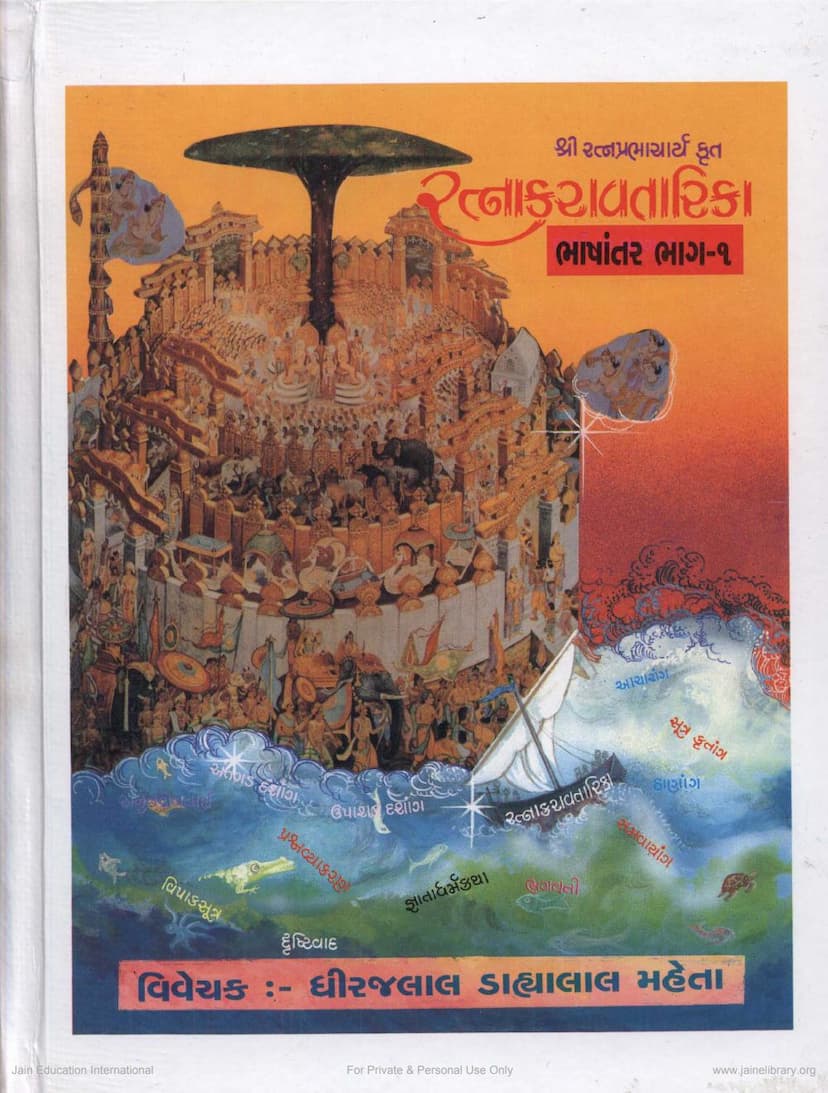Ratnakaravatarika Part 1
Added to library: September 2, 2025

Summary
Certainly! Here's a comprehensive summary of the provided Jain text, "Ratnakaravatarika Part 1," based on the catalog link and the transcribed pages.
The provided text is the first part of the Gujarati translation of Ratnakaravatarika, which is a commentary on Pramananayatattvalok (an important Jain philosophical text on logic and epistemology) by Acharya Vādidevasūri. The translation and commentary are by Dhirajlal Dahyalal Mehta. The publisher is Jain Dharm Prasaran Trust, Surat.
Overall Purpose:
The Ratnakaravatarika is a commentary (Tika) that aims to make the profound philosophical treatise "Pramananayatattvalok" accessible. This particular volume covers the first two chapters (Parichchhed 1 and 2) of the original work. The primary focus of these chapters, as indicated by the title "Pramananayatattvalok," is on the principles of Pramana (valid knowledge or means of knowledge) and Naya (standpoints or partial truths). The commentary seeks to clarify complex philosophical concepts and refute opposing viewpoints from other Indian philosophical schools.
Key Themes and Content Covered in Part 1 (Parichchhed 1 & 2):
Parichchhed 1: Pramana Swaroop Nirnay (Determination of the Nature of Pramana)
- The Nature of Pramana: The text begins by establishing what constitutes valid knowledge (Pramana). It argues that knowledge itself is Pramana, as it is the ultimate means that guides action towards what is desirable and away from what is undesirable.
- Refutation of Non-Jain Views on Pramana: A significant portion of the first chapter is dedicated to refuting the theories of other philosophical schools regarding Pramana.
- Buddhism (Śūnyavāda/Vijnapti-mātra-vāda): The text likely discusses and refutes the Buddhist notion that only momentary mental perceptions or consciousness (vijñapti-mātra) are real, and external objects or words have no independent reality. It critiques the theories regarding the relationship between words and their meanings, and the concept of "apoha" (negation) as a linguistic tool.
- Nyaya and Mimamsa: The commentary likely engages with the Nyaya and Mimamsa schools' views on the origin and nature of Pramana, particularly their emphasis on Indriya-sannikarsha (contact between senses and sense-objects) as the basis for perception. The text defends the Jain view by arguing that knowledge (pramana) is intrinsically related to the object and its nature, and that sensory contact alone is insufficient. It also likely discusses the concept of knowledge being either self-revealing (svaprakāśaka) or other-revealing (paraprakāśaka).
- The Nature of Knowledge: The text asserts that knowledge must be vyavasāyātmaka (decisive or definitive) to be considered valid Pramana. It refutes mistaken perceptions (samārop) like viparyaya (misapprehension), samśaya (doubt), and anadhyavasāya (indecision) as being invalid knowledge (apramana).
- The "Param" (Other): The text clarifies the meaning of "param" (other), differentiating it from knowledge (jñāna), and refuting views that deny the existence of external reality (śūnyavāda).
- The Role of Words and Meaning: The text likely elaborates on the relationship between words and their meanings, and the concept of Saptabhangi (the seven-valued logic of conditional predication), which is a core Jain epistemological principle.
- The Goal of Pramana: The ultimate goal of Pramana is to lead to the correct understanding of reality, which, according to Jainism, is anekanta (non-one-sidedness) and is ultimately grasped through the lens of Syadvada (the doctrine of manifold perspectives).
Parichchhed 2: Pratyaksha Pramana Swaroop Nirnay (Determination of the Nature of Perception)
- Classification of Pramana: The text categorizes Pramana into two main types: Pratyaksha (direct perception) and Paroksha (indirect knowledge).
- Pratyaksha Pramana: The second chapter delves into the detailed analysis of Pratyaksha Pramana.
- Practical vs. Ultimate Pratyaksha: It introduces the distinction between practical or empirical perception (Sāṃvyavahārika Pratyaksha) and ultimate or transcendental perception (Pāramārthika Pratyaksha).
- Sensory vs. Non-Sensory Perception: Sāṃvyavahārika Pratyaksha is further divided into sensory (indriya-nibandhana) and non-sensory (anindriya-nibandhana) types.
- The Stages of Sensory Perception: The text describes the four stages of sensory perception: Avagraha (initial apprehension), Īhā (conative effort to know), Avāya (deduction or inference of specific characteristics), and Dhāraṇā (retention or memory of the perceived object). These stages are explained in relation to the functioning of the five external senses and the internal sense of mind.
- Sensory vs. Non-Sensory Organs: A discussion is presented on the nature of sensory organs, with arguments about whether they are "prāpyakāri" (acting upon reaching the object) or "aprapyakāri" (acting without reaching the object). The text discusses the visual sense (chakshu) and the mind (mana) in this context, contrasting them with other senses.
- Pāramārthika Pratyaksha: This section likely discusses the higher forms of direct perception unique to liberated souls or advanced practitioners, such as avadhi-jñāna (clairvoyance) and manaḥparyāya-jñāna (telepathy). It also touches upon the concept of Kevala-jñāna (omniscience), the highest form of direct perception, and likely refutes arguments against the existence of Omniscients (Sarvajña) and the concept of Ishvara (God) as the creator.
- Refutation of Opposing Views: The commentary engages with various philosophical arguments, including refutations of the views of Buddhist schools on perception, and debates on concepts like the creator God (Īshvara). It also discusses the nature of Arhats (perfected souls) and their speech, asserting their infallibility and connection to right knowledge.
Author and Commentary:
- Original Author: Vādidevasūri is the author of "Pramananayatattvaloka."
- Commentator (Tika): The commentary itself, "Ratnakaravatarika," is by Ratnakaraacharya, who is a disciple of Vādidevasūri.
- Translator/Commentator of this Gujarati version: Dhirajlal Dahyalal Mehta.
- Publisher: Jina Dharm Prakashan Trust, Surat.
- Historical Context: The introduction mentions the famous debate between Vādidevasūri and the Digambara scholar Kumudachandra in the court of King Siddharaja, highlighting Vādidevasūri's intellectual prowess and victory.
Significance:
The Ratnakaravatarika, by providing a detailed explanation and commentary on Vādidevasūri's work, plays a crucial role in preserving and propagating Jain logic and epistemology. It highlights the Jain perspective on the nature of knowledge, perception, and reality, engaging in rigorous debate with other philosophical systems. The translation into Gujarati makes these complex ideas accessible to a wider audience interested in Jain philosophy.